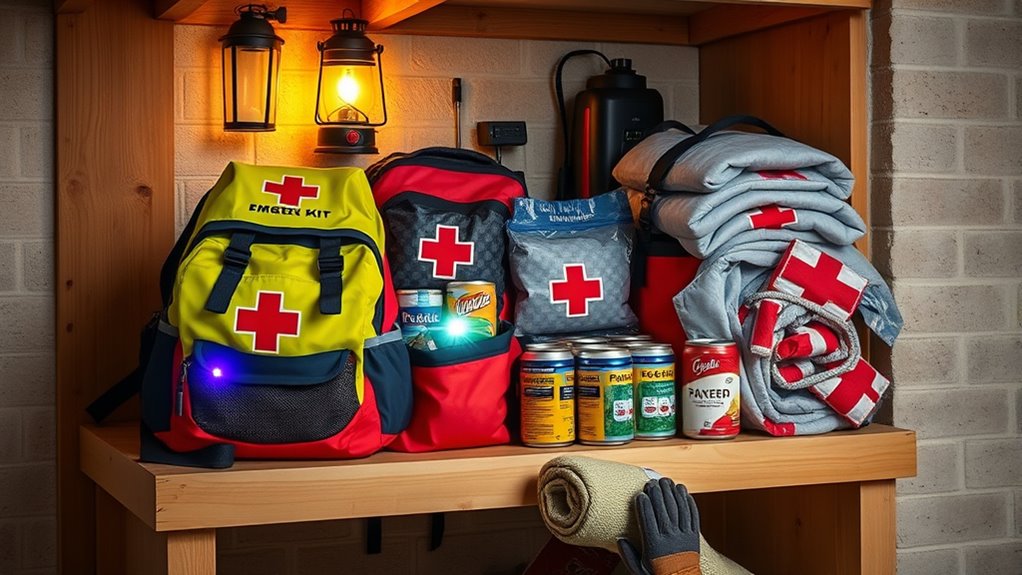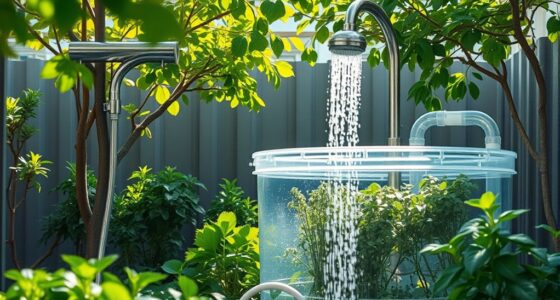To prepare your home for the unexpected, assemble an emergency kit with essentials like first aid supplies, clean drinking water, non-perishable food, flashlights, batteries, and a portable radio. Include items for specific needs, such as medications or pet supplies. Organize everything in a durable, accessible container, and regularly check or update your supplies. Being proactive helps reduce risks and keeps your family safe; learn more to make sure you’re fully prepared for any situation.
Key Takeaways
- Include essential first aid supplies like bandages, antiseptic wipes, and medications for immediate injury treatment.
- Stock water purification tools such as filters, tablets, or boiling equipment to ensure safe drinking water.
- Store non-perishable food, extra clothing, and blankets for sustenance and warmth during emergencies.
- Organize supplies in a durable, accessible container and regularly update to replace expired or used items.
- Equip your home with safety devices like batteries, flashlights, weather radios, and communication tools for emergencies.

Having an emergency kit ready can make all the difference during unexpected situations. When disaster strikes, whether it’s a storm, earthquake, or power outage, being prepared means you can respond quickly and effectively. One of the most important components of your kit is ensuring you have the right first aid essentials. These include bandages, antiseptic wipes, pain relievers, and any necessary medications. With these supplies on hand, you can treat minor injuries immediately, preventing infections and reducing discomfort. It’s also wise to include items like scissors, tweezers, and gloves so you can handle wounds safely and hygienically. By regularly checking and updating your first aid supplies, you make sure everything remains in good condition and ready for use when needed. Proper organization and accessible storage of your supplies can save valuable time during an emergency. Water is essential for survival, especially during emergencies when regular supplies might be disrupted. Knowing water purification methods is crucial to ensure you have access to safe drinking water. Simple methods like boiling water for at least one minute can effectively kill most pathogens. If you don’t have a stove or fire, portable water filters or purification tablets are excellent alternatives. These tools can remove bacteria, viruses, and parasites, making questionable water safe to drink. In a pinch, you can also use household bleach—adding a few drops to water and letting it sit for 30 minutes can make it drinkable, provided you use the correct amount. Including water purification supplies in your emergency kit ensures you’re prepared to handle contaminated water sources, which are common during disasters. Beyond the essentials, consider adding items that improve your safety and comfort. Flashlights, batteries, and a portable radio keep you informed and help you see in the dark. Non-perishable food, extra clothing, and blankets provide sustenance and warmth. It’s also important to plan for specific needs, like supplies for infants, elderly family members, or pets. Organize everything in a durable, accessible container, and keep it in a designated spot known to all household members. Regularly review and restock your kit, especially after use or when supplies expire. Being proactive and thorough in your preparations ensures you’re less vulnerable during emergencies and can maintain health and safety until help arrives or conditions improve. Additionally, understanding home safety technology such as battery-powered alarms or weather radios can significantly enhance your preparedness and response capabilities.
Frequently Asked Questions
How Often Should I Update My Emergency Kit?
You should update your emergency kit regularly to guarantee it’s ready when needed. Follow a maintenance schedule, such as every six months, to check for expired items and replace them. Kit replenishment is vital; refresh food, water, and supplies annually. Keep an eye on medications and batteries, and update your kit after any significant life changes. Regular maintenance helps you stay prepared for unexpected situations.
What Specific Items Are Essential for Children or Seniors?
For children, include child safety items like diapers, formula, and favorite comfort items. For seniors, consider mobility aids or medications. You should also add extra batteries, a flashlight, and a first aid kit. Think about their specific needs to guarantee safety and comfort. This way, you’re prepared for any situation, making sure your loved ones stay safe and supported during emergencies.
How Do I Customize an Emergency Kit for Different Disasters?
So, you wanna be the hero with a perfectly customized emergency kit, huh? First, consider the disaster you’re prepping for—floods, earthquakes, or hurricanes—and pack disaster-specific gear accordingly. Think water, sturdy shoes, or waterproof clothing. Then, add personalized safety measures, like medications or important documents. By tailoring your kit to each scenario, you’re ensuring you’re ready for anything life throws your way. Who knew preparedness could be so clever?
Can I Include Pet Supplies in My Emergency Kit?
Yes, you can include pet supplies in your emergency kit. Consider your pet’s needs, such as food, water, medications, and comfort items. Emergency pet supplies guarantee your furry friends stay safe and calm during a crisis. Pack enough for several days, and include items like leashes, a first aid kit, and any special necessities. This way, you’re prepared to care for your pet just as well as yourself in emergencies.
Where Is the Safest Storage Location in My Home?
Imagine your home as a fortress, with the safest storage location as its hidden vault. You should choose a spot with excellent storage safety, like a high, waterproof shelf or a closet tucked away from windows and doors. Avoid obvious places. Hidden locations, such as behind a false wall or under a staircase, keep your emergency kit secure and accessible while protecting it from damage or theft during a crisis.
Conclusion
Now that you know how to prepare your emergency kit, you’re better equipped to face the unexpected head-on. Having a plan and the right supplies means you’re not caught off guard when disaster strikes. Remember, it’s better to be safe than sorry—because when it comes to emergencies, a little foresight goes a long way. Stay prepared, stay calm, and keep your kit ready; you never know when you’ll need it most.









